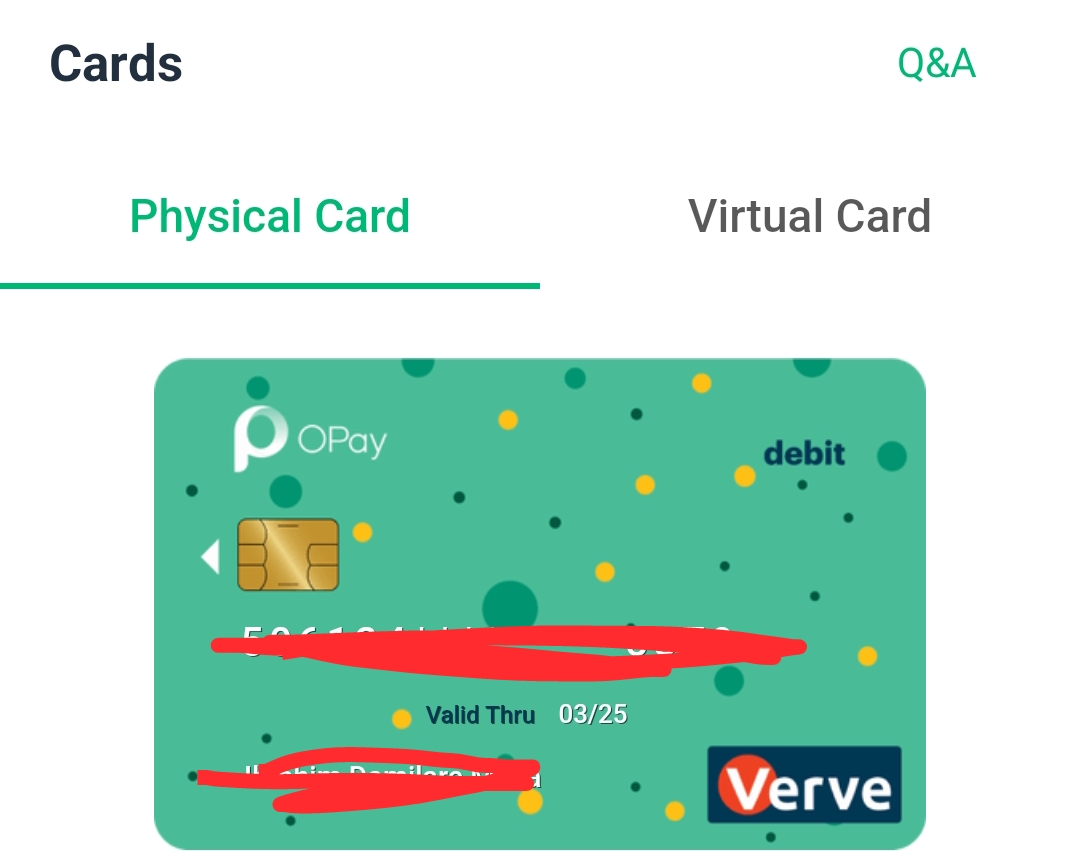OPay Virtual Card And Physical Card are two types of cards offered by OPay. While they may seem similar, they have significant differences.
This post will explore the differences between OPay virtual card and opay physical debit card.
OPay is a digital financial service company that has made financial transactions in Nigeria very easy and convenient.
With their app, users can send and receive money, buy airtime and data, pay bills, and even invest.
One of the features of the OPay app is the virtual and debit cards, which users can use to make online purchases and perform other financial transactions.
OPay Virtual Cards.

Opay virtual card is a digital card that can only be used online.
It is not a physical card, but a virtual representation of a debit or credit card. Virtual cards have become popular in recent years due to their convenience and security.
OPay virtual cards work like any other virtual card. They are used for online purchases and other transactions that require a card.
Also Read: How To Get OPay Debit Card? 2023
OPay virtual cards are created within the app, and users can generate as many virtual cards as they want.
Users can name their virtual cards and also assign them to different purposes, such as for online shopping, paying bills, or subscribing to services.
Each virtual card has a unique card number, expiration date, and CVV code, just like a physical card.
One significant advantage of OPay virtual cards is that they offer enhanced security. Virtual cards are not linked to any physical card, which means that even if the card is compromised, the user’s physical card is safe.
In addition, virtual cards can be easily canceled or deleted, which makes them ideal for one-time transactions or for use with merchants that users do not trust.
Another advantage of OPay virtual cards is that they are free. Users do not need to pay any fees to generate virtual cards, which makes them accessible to everyone.
Also, virtual cards can be generated instantly within the app, which means that users can start using them immediately.
However, there are some disadvantages of using OPay virtual cards. The primary disadvantage is that virtual cards can only be used for online transactions.
They cannot be used to withdraw cash from an ATM or to make in-store purchases. Also, some merchants may not accept virtual cards, which means that users may not be able to use them for all transactions.
OPay Debit Cards

Opay debit card is a physical card that is linked to a user’s bank account. It allows users to make transactions by withdrawing cash from an ATM, making in-store purchases, and performing other financial transactions.
OPay debit cards work like any other debit card. Users can use their OPay debit cards to withdraw cash from any ATM that accepts Verve cards and make payments at any POS terminal that accepts Verve cards.
Also Read: How can I get opay account number?
OPay debit cards offer several advantages over virtual cards. The primary advantage is that they can be used for in-store purchases and cash withdrawals.
This means that users can use their OPay debit cards for all their financial transactions, making it a more versatile option than virtual cards.
Another advantage of OPay debit cards is that they are more widely accepted than virtual cards.
Most merchants that accept card payments will accept debit cards, which means that users can use their OPay debit cards for almost all their transactions.
However, OPay debit cards also have some disadvantages. The primary disadvantage is that they are linked to a user’s bank account, which means that if the card is compromised, the user’s bank account is also at risk. This makes OPay debit cards less secure than virtual cards.
Another disadvantage of OPay debit cards is that they are not free.
Users need to pay a one-time fee of N600 to activate their OPay debit cards. Also, users may be charged transaction fees by their bank or by OPay for using their debit cards.
Differences Between OPay Virtual Card and Debit Card.

Now that we have looked at the features of OPay virtual cards and debit cards, let’s explore the differences between them.
- Physical vs. Digital
The most obvious difference between OPay virtual cards and debit cards is that virtual cards are digital, while debit cards are physical.
This means that users can use their OPay debit cards for in-store purchases and cash withdrawals, while virtual cards can only be used for online transactions.
- Security
Security is another significant difference between OPay virtual cards and debit cards. Virtual cards offer enhanced security because they are not linked to a user’s bank account.
If a virtual card is compromised, the user’s bank account is not at risk. Virtual cards can also be easily canceled or deleted, which makes them ideal for one-time transactions or for use with merchants that users do not trust.
Debit cards, on the other hand, are linked to a user’s bank account, which means that if the card is compromised, the user’s bank account is also at risk. This makes OPay debit cards less secure than virtual cards.
- Cost
Another difference between OPay virtual cards and debit cards is the cost.
Virtual cards are free, while users need to pay a one-time fee of N600 to activate their OPay debit cards. Also, users may be charged transaction fees by their bank or by OPay for using their debit cards.
- Acceptance
OPay virtual cards and debit cards also differ in their acceptance. Virtual cards can only be used for online transactions, while debit cards can be used for in-store purchases and cash withdrawals.
Debit cards are also more widely accepted than virtual cards, as most merchants that accept card payments will accept debit cards.
Also Read; Opay and Palmpay Which Is Better?
Conclusion
In conclusion, OPay virtual cards and debit cards both have their advantages and disadvantages.
Virtual cards offer enhanced security, are free, and can be easily canceled or deleted.
However, they can only be used for online transactions and may not be accepted by all merchants.
Debit cards, on the other hand, are more versatile and can be used for in-store purchases and cash withdrawals.
However, they are less secure than virtual cards, and users need to pay a one-time fee to activate them.

